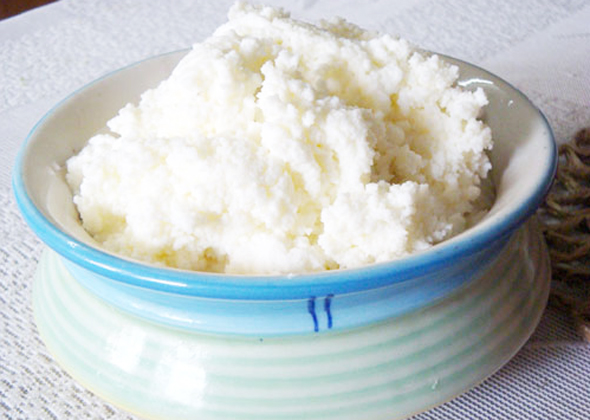Mama’s Punjabi Recipes: Ghar da Makhan (Homemade Butter)
Long before it became fashionable to eat Amul butter that you bought in tiny slabs from the corner store; long before sliced bread became so widely available and eaten and long before different types of breakfast cereals became popular there was a simple way to start your day in the mornings in North India: get a crispy roti, heat it up and spread a little homemade butter on it. As it melted, you could dab a piece of roti in it and chew it down with a steel glass full of hot milk or tea.
Butter as we know it now is homogenized and pasteurized, sold in sticks or plastic bowls. But many homes in India, and virtually all in the rural areas, still take pride in the butter they make at home. Some women spin long yarns about how can make so much butter that they turn the surplus into ghee (clarified butter) to use in cooking! But in the cities, making your own makhan is now a dying art.
Homemade makhan is made from the malai (film of cooled cream) that is collected over several days from the top of boiled milk. It is scooped off and carefully stored in a bowl left in the fridge. Some people actually prefer to eat the malai itself spread on a crispy roti or toast and sprinkled with fine ground sugar. When it is being made, the by-product is plain lassi (buttermilk), a soothing drink on hot days.
The final product, makhan, is white, unsalted and sweet, with a little graininess to it. It is collected and packed tightly in a bowl and has a low melting point when taken out of the fridge. A dollop of makhan tastes good, especially melting on a gobi parantha or spread generously over a piece of crispy, fire-toasted Indian bread, which has a taste unlike those breads you find in the West.
Ingredients :
½ gallon saada doodh (whole milk)
2 tbsp dahinn (plain yogurt) – for the starter
2 cups thanda pani (cold water)
Directions:
1. Pour two tablespoons of water in a pot, preferably one with a heavy base, to coat it, then pour the milk in.
2. Place it over low heat and let the milk slowly come to a boil. As it does, a soft skin will form over the top and it will start to puff up and rise. Turn off the heat and let the milk cool down.
3. When sufficiently cool, do not stir the milk, cover the pot and place it in the fridge overnight. A thick film of coagulated cream will form over the top of the milk.
4. In the morning, take the milk out of the fridge and carefully remove the cream, collecting it in a bowl. Cover the bowl and place in the fridge.
5. Repeat the procedure each night for a week, collecting the cream in the same bowl.
6. On the eighth day, take the 2 tbsp of yogurt out of the fridge and warm up it over low heat. Don’t use it cold as the fermentation will not take hold easily.
7. Place the collected cream in a pot and make it lukewarm over low heat, stirring occasionally. Pour in the warm yogurt and mix well.
8. Now cover the pot, wrap it with a thick blanket and place it in a warm place like inside the oven.
9. It is best to start this overnight. If you start in the daytime, then let the pot sit undisturbed for at least 12 hours.
10. Take off the blanket and the cream should be hardened and well-formed. Using a large ladle or hand-mixer, vigorously beat the cream for 10 minutes. The butter will clump together and separate out from the liquid, which is the buttermilk.
11. Slowly pour the cold water over the ladle or mixee to clean it and help to separate the butter. Drain the water into a bowl to drink the buttermilk or keep it to make kaddi later. Collect the clumps of butter together in a bowl, cover and keep in the fridge to use when desired.
MAMA’S TIP OF THE WEEK
FOR LONG SHELF LIFE, DON’T ADD SALT TO YOGURT
Yogurt or raita goes well with most Indian food as it helps to soothe the palate and take the bite of extra spiciness out of the meal. Often, people will eat a meal only with yogurt, like when eating a hot parantha or biryani or khichiddi and maybe with a slice of pickle. But if you want to use the yogurt again later, it is best not to mix in any salt once it is opened up and used as the salt will make the yogurt separate and shed water.
Shakuntla Malhotra is a skilled cook of Punjabi dishes made in the old-fashioned style that she learnt as a young woman in her ancestral home in Lyallpur, India before it became part of Pakistan after the Partition in 1947. People have often admired her cooking for its simplicity and taste that comes with each mouthful. Even in her mid-eighties, she continues to cook daily and agreed to share some of her delectable Punjabi recipes.


